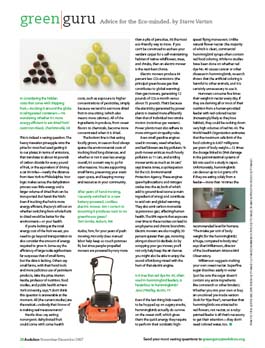
Green Guru: Environmental Costs of Dried Fruit, Battery-Powered Mowers, and Red #40 on Hummers
Since I write this column for Audubon Magazine, I thought I would share my (laboriously researched) advice with Eco Chick readers.
In considering the hidden costs that come with shipping fruit—trucking it around the globe in refrigerated containers—I’m wondering whether it’s more energy efficient to eat dried fruit?
—Justin Van Kleeck, Charlottesville, VA
This is indeed a vexing question. The heavy Hawaiian pineapple wins the prize for most fuel used getting it to our plates; in terms of emissions, that translates to about 40 pounds of carbon dioxide for every pound of fruit, or the equivalent of driving a car 80 miles—nearly the distance from New York to Philadelphia. Your logic makes sense; the dehydration process uses little energy and a larger volume of dried fruit can be transported. But here’s the hitch: Even if trucking the fruit is more energy efficient, the jury’s still out on whether switching from whole fruits to dried would be better for the environment—or your health.
For the rest of the answer, go to Audubon Magazine’s Green Guru page!
After years of hand mowing, I recently switched to a new battery-powered, cordless electric mower. Am I correct in assuming it produces next to no greenhouse gases?
—Tom Sernka, Auburn, WA
Kudos, Tom, for your years of push mowing. Not only does manual labor help keep us couch potatoes fit, but since people-propelled mowers are powered by nary more than a pile of pancakes, it’s the most eco-friendly way to mow. If you can’t be convinced to eschew your verdant carpet for a self-maintaining habitat of native wildflowers, trees, and shrubs, then an electric mower is the next-best choice.
For the rest of the answer, go to Audubon Magazine’s Green Guru page!
Is it true that red dye No. 40, often used in hummingbird feeders, is hazardous to hummingbirds?
—Jane O’Malley, Austin, TX
Even if the last thing kids need is to be hopped up on sugary snacks, hummingbirds actually do survive on the sweet stuff, which gives them the quick energy they require to perform their acrobatic high-speed flying maneuvers. Unlike natural flower nectar (the majority of which is clear), commercial hummingbird syrups often contain red food coloring. While no studies have been done on whether red dye No. 40 causes cancer or other diseases in hummingbirds, research shows that the artificial coloring is harmful to other animals, and it is certainly unnecessary to use it.
For the rest of the answer, go to Audubon Magazine’s Green Guru page!





